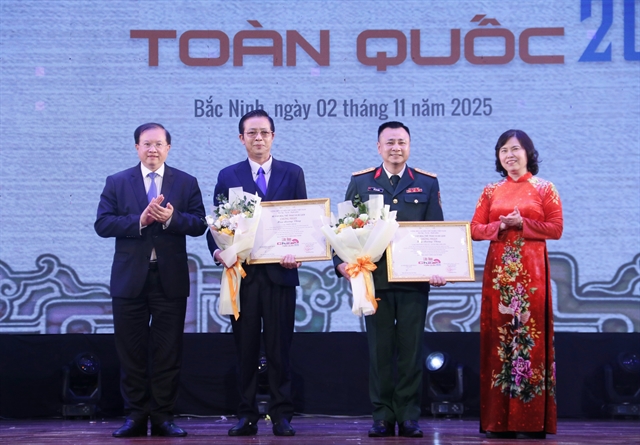 Economy
Economy

By developing an agricultural value chain, the southern province of Tây Ninh expects to raise its agricultural GDP and average farmer income per year from the current figures of US$3 billion and $1,500 to $8 billion and $5,000, respectively, after five years.
 |
| Tapioca starch being packaged at the Tây Ninh Tapioca Joint Stock Company. Tây Ninh province expects to raise its agricultural product value to more than US$8 billion in five years. — VNA/VNS Photo Thanh Tân |
HCM CITY — By developing an agricultural value chain, the southern province of Tây Ninh expects to raise its agricultural GDP and average farmer income per year from the current figures of US$3 billion and $1,500 to $8 billion and $5,000, respectively, after five years.
Speaking at an international conference held in Tây Ninh Province last week, Phạm Văn Tân, chairman of the provincial People’s Committee, said Tây Ninh has advantages for agricultural development as its agricultural land accounts for more than 65 per cent (nearly 270,000 ha) of natural land, with rather flat terrain making it easy for agricultural production.
The province is home to the Dầu Tiếng irrigation system, the largest of its kind in the country, which can supply water to 47,000ha of farmland, he said.
But, majority of the province’s farm produce was consumed as raw produce with low added value, he said, adding that the volume of products meeting quality standards remained modest.
“Export volume was still small, especially exports to demanding markets, such as Japan, South Korea, the US and EU,” he said.
He attributed the situation to small scale production and a lack of connection among stake holders in the production chain.
The provincial agricultural sector is focusing on restructuring its agricultural production, with a concentration on enhancing connections among stakeholders involved in the production chain, and between production and consumption markets, he said.
“The province will set aside about 1,800ha of land (which is revoked from farms) to make zoning plans and develop infrastructure to meet the demand for agricultural development to attract domestic and foreign investors who are capable in terms of resources, technology and market, to develop agricultural projects following a value chain.”
These businesses will be the foundation that will lead local farmers, farms and businesses to develop, he said.
The province will map out policies to attract more businesses to invest in the agricultural value chain in the province and build measures to speed up the application of good agricultural practices and high technologies in its agricultural production to improve competiveness of its farm produce, he said.
Trần Lưu Quang, secretary of the provincial Party Committee, said “With a desire to do something to gradually to improve the lives of 78 per cent of the residents living in rural areas, to help farmers get rich on their own land and meanwhile, to help the province to narrow the development gap with other localities in the region, after seven months of active preparation, Tây Ninh’s agricultural value chain for international market integration was initially established.”
Delegates at the conference agreed that agricultural production following value chains is a must because this would help the province’s farm produce meet the market’s quantity and quality requirements and increase farmer incomes.
Under the pilot model, the province will concentrate on developing the value chain for fruits and vegetables since there is a huge demand for the products globally.
Kato Ryoji of the Japanese OTA Floriculture Auction, a leading company operating the OTA wholesale market for flowers in Tokyo, said Japanese people are very fond of Vietnamese tropical fruits since tropical fruits cannot be cultivated in his country.
This offers a great potential for Vietnamese fruits to penetrate the market, he said.
Raj Kumar Sharma, CEO of US-based Sunrise Orchards, said the US also has great demand for tropical fruits like bananas, coconuts, guavas and papayas since there are a lot of people from Asia who have migrated to the US and they all want their home fruits.
But to access the US market, the fruits must be safe, he said.
Similarity, Kato Ryoji said, “When we import, we care a lot about product quality and traceability.”
Producing fruits and vegetables by value chain would make it easy to trace the origin of a product and ensure their quality, delegates said. They believe that the model would offer great success for the province and raise its agricultural GDP and average farmer income per year from the current figures of $3 billion and $1,500 to $8 billion and $5,000.
The model has received great attention from domestic and foreign investors.
Enterprises from the US, Germany and Japan committed to invest $1 billion in the provincial agricultural value chain, while domestic investors at the conference pledged to invest VNĐ15 trillion ($660.79 million) in the value chain.
“There is a lot of potential in Tây Ninh Province and I am willing to teach the farmers in the province to grow safe fruits … We can help them market their products, not only to the US but also all over the world,” Raj Kumar Sharma said.
Nguyễn Văn Bình, head of the Party Central Committee’s Economic Commission, suggested the Ministry of Agriculture and Rural Development should have policies to help the province successfully develop the pilot model of the hi-tech agricultural value chain.
He also asked the State Bank of Việt Nam to offer preferential loans to approved projects.
Organised by the Ministry of Agriculture and Rural Development in collaboration with Tây Ninh People’s Committee, the Việt Nam Organic Agricultural Economics Institute, and the Nhà Quản Lý (Manager) magazine, the conference attracted more than 500 local and foreign delegates. — VNS




